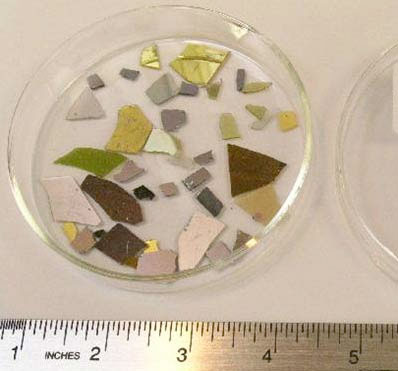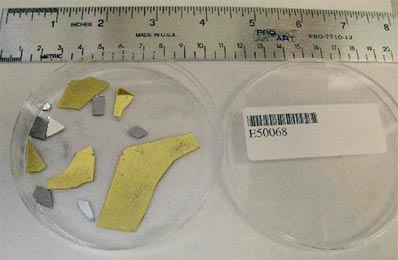
Spaceflight Now +

|

|

|

|

Premium video content for our Spaceflight Now Plus subscribers.

Friday's Genesis update
 On Friday, Sept. 10, officials hold a news conference from Utah to update reporters on the recovery operations to salvage the Genesis sample return mission. (44min 47sec file) On Friday, Sept. 10, officials hold a news conference from Utah to update reporters on the recovery operations to salvage the Genesis sample return mission. (44min 47sec file)
 Play audio Play audio

Genesis recovered
 Workers recover the Genesis solar wind samples from the impact crater and take the equipment into a facility for examination. (2min 08sec file) Workers recover the Genesis solar wind samples from the impact crater and take the equipment into a facility for examination. (2min 08sec file)
 Play video Play video

Post-impact news briefing
 Officials hold a post-landing news conference in Utah a couple hours after Genesis returned to Earth on Sept. 8. (40min 52sec file) Officials hold a post-landing news conference in Utah a couple hours after Genesis returned to Earth on Sept. 8. (40min 52sec file)
 Play video Play video

Capsule first spotted
 Powerful tracking cameras spot the Genesis capsule for the first time a couple hundred thousand feet above Earth, prompting applause in the control centers. But just moments later, that joy turned to heartbreak. (1min 02sec file) Powerful tracking cameras spot the Genesis capsule for the first time a couple hundred thousand feet above Earth, prompting applause in the control centers. But just moments later, that joy turned to heartbreak. (1min 02sec file)
 Play video Play video

Genesis crash lands
 The Genesis sample return capsule tumbles through the sky and impacts the desert floor in Utah after its speed-slowing chute and parafoil failed to deploy for a mid-air recovery by a helicopter. (2min 29sec file) The Genesis sample return capsule tumbles through the sky and impacts the desert floor in Utah after its speed-slowing chute and parafoil failed to deploy for a mid-air recovery by a helicopter. (2min 29sec file)
 Play video Play video

Slow-motion
 This slow-motion video shows the Genesis capsule slamming into the ground. (1min 06sec file) This slow-motion video shows the Genesis capsule slamming into the ground. (1min 06sec file)
 Play video Play video

Aerial views of crater
 Aerial views show the Genesis capsule half buried in the Utah desert floor after its landing system suffered a failure. (1min 53sec file) Aerial views show the Genesis capsule half buried in the Utah desert floor after its landing system suffered a failure. (1min 53sec file)
 Play video Play video

Recovery helicopters
 The primary and backup recovery helicopters take off with escort from a Blackhawk in preparation for the mid-air retrieval of Genesis. (1min 01sec file) The primary and backup recovery helicopters take off with escort from a Blackhawk in preparation for the mid-air retrieval of Genesis. (1min 01sec file)
 Play video Play video

The original plan
 Animation shows how the Genesis spacecraft was supposed to return. Expert narration provided by JPL entry, descent and landing expert Rob Manning. (5min 29sec file) Animation shows how the Genesis spacecraft was supposed to return. Expert narration provided by JPL entry, descent and landing expert Rob Manning. (5min 29sec file)
 Play video Play video

Return of Genesis
 NASA's Genesis spacecraft will return to Earth on Sept. 8 with a capsule containing samples collected of solar wind. Officials preview the dramatic homecoming in this news conference. (50min 50sec file) NASA's Genesis spacecraft will return to Earth on Sept. 8 with a capsule containing samples collected of solar wind. Officials preview the dramatic homecoming in this news conference. (50min 50sec file)
 Play video Play video

Genesis status
 Mission officials provide a Genesis status briefing from Utah on Sept. 7 -- one day before the craft turns to Earth. (43min 47sec file) Mission officials provide a Genesis status briefing from Utah on Sept. 7 -- one day before the craft turns to Earth. (43min 47sec file)
 Play video Play video

 Become a subscriber Become a subscriber
 More video More video

|

|

|

|

|

|

Genesis team hopeful about solar wind samples
MISSION CONTROL STATUS REPORT
Posted: September 16, 2004
Genesis team scientists and engineers continue their work on the mission's sample return canister in a specially constructed clean room at the U.S. Army Proving Ground in Dugway, Utah. As more of the capsule's contents are revealed, the team's level of enthusiasm for the amount of science obtainable continues to rise.

These are pieces of collector array wafers recovered from the impact site of the Genesis sample return capsule. The Genesis curation team is very optimistic that they will be able to recover almost all of the solar wind samples from these pieces. Credit: NASA-JSC
|
At present, the science canister that holds the majority of the mission's scientific samples is lying upside down - on its lid. Scientists are very methodically working their way "up" from the bottom portion of the canister by trimming away small portions of the canister's wall.
The team continues to extract, from the interior of the science canister, small but potentially analyzable fragments of collector array material. One-half of a sapphire wafer was collected Tuesday - the biggest piece of collector array to date.
The mission's main priority is to measure oxygen isotopes to determine which of several theories is correct regarding the role of oxygen in the formation of the solar system. Scientists hope to determine this with isotopes collected in the four target segments of the solar wind concentrator carried by the Genesis spacecraft.
The condition of these segments will be better known over the next few days, after the canister's solar wind concentrator is extricated. At this time, it is believed that three of these segments are relatively intact and that the fourth may have sustained one or more fractures.

These are pieces of collector array wafers recovered from the impact site of the Genesis sample return capsule. The Genesis curation team is very optimistic that they will be able to recover almost all of the solar wind samples from these pieces. Credit: NASA-JSC
|
There are no concrete plans regarding the shipping date of the Genesis capsule or its contents from Dugway to the Johnson Space Center in Houston.
The team continues its meticulous work and believes that a significant repository of solar wind materials may have survived that will keep the science community busy for some time.
The Genesis sample return capsule landed well within the projected ellipse path in the Utah Test and Training Range on Sept. 8, but its parachutes did not open. It impacted the ground at nearly 320 kilometers per hour (nearly 200 miles per hour).

Additional coverage for subscribers:
 VIDEO:
POST-LANDING NEWS CONFERENCE QT VIDEO:
POST-LANDING NEWS CONFERENCE QT

 VIDEO:
TRACKING CAMERAS FIRST SPOT CAPSULE DURING DESCENT QT VIDEO:
TRACKING CAMERAS FIRST SPOT CAPSULE DURING DESCENT QT
 VIDEO:
GENESIS CAPSULE TUMBLES TO A HIGH-SPEED IMPACT QT VIDEO:
GENESIS CAPSULE TUMBLES TO A HIGH-SPEED IMPACT QT
 VIDEO:
SLOW-MOTION VIEW OF CAPSULE SLAMMING INTO GROUND QT VIDEO:
SLOW-MOTION VIEW OF CAPSULE SLAMMING INTO GROUND QT
 VIDEO:
AERIAL VIEWS OF CAPSULE HALF BURIED IN IMPACT CRATER QT VIDEO:
AERIAL VIEWS OF CAPSULE HALF BURIED IN IMPACT CRATER QT
 VIDEO:
RECOVERY HELICOPTERS TAKE OFF EARLIER TODAY QT VIDEO:
RECOVERY HELICOPTERS TAKE OFF EARLIER TODAY QT
 VIDEO:
NARRATED ANIMATION SHOWS ORIGINAL RETURN PLAN QT VIDEO:
NARRATED ANIMATION SHOWS ORIGINAL RETURN PLAN QT
 SUBSCRIBE NOW SUBSCRIBE NOW

|

|

|

|
|



